(diff) ← Older revision | Current revision (diff) | Newer revision → (diff)
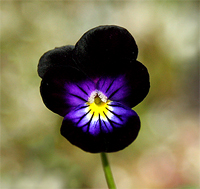 | Heart of Akajia
Seasons: Late Summer-Early Fall
Appearance: A black flower with a dark purple heart and yellow stamen. It grows to 2 inches in diameter, and typically 6 inches tall. It grows singularly from the ground, though often many will grow in one area.
Purposes: It is commonly a wildflower, though many will plant it in their gardens as a border. The scent is sweet, but too weak for use in perfume, though it can be used if large bunches are used to concentrate the scent. Requires little water to grow, but is considered good luck if it blossoms, unwarranted, in one’s yard.
Clime: Found in the upper areas of the cliffs, extending out into the grasslands.
|
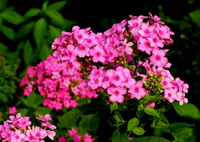 | Menitides
Seasons: Summer
Appearance: Menitides grow in bushes, with clumps of inch-wide flowers blooming at a time. The leaves are long, pointed, and thin, but have an attractive dark green shade when properly watered. The bushes grow and spread fast and considered by some to be a weed. The scent is flowery and attractive, but weak due to the individual flower’s small size.
Purposes: Commonly planted outside houses as an attractive hedge, menitide bushes are common sights in all of Riverfall’s parks. They are quick to grow large and lush near the waterfall, and must be continually trimmed down during the summer.
Clime: Grows best when warm and moist. Bushes become more scrub-like as you get further away from the river, and bloom time increases with the amount of water that is available.
|
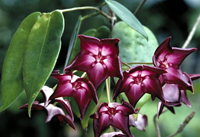 | Mooneyes
Seasons: Spring - Summer
Appearance: Pointed, dark purple flowers with a softly glowing center that only bloom in the evening and night. Leaves are thick and puffy, and can be several inches across. Flowers typically do not grow larger than 2 inches across. The main attraction however, can be seen at night. The pollen of the mooneyes is phosphorescent, and gathers light during the evening to fully bloom into glowing bunches at night. It does not glow for the entire night, and the glow dies several bells before dawn. There is a common mutation of Mooneye that blooms during the day, and the bulb continues to glow while the petals are closed at night.
Purposes: The pollen loses its fluorescent potency quickly after harvesting, so research among Riverfall’s artists has worked on ways to extend its life, for use in paints, decorations, and clothing.
Clime: Mooneyes are fairly rare, and many find that they will bloom where they please, despite efforts to cultivate them. They can be seen throughout Riverfall and into the Grasslands, but do not grow close to the ocean sprays.
|
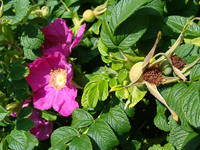 | Rose Hips
Seasons: Summer
Appearance: Rose hips grow in small bushes that often infiltrate other bushes to grow higher. The flower is floppy and pinkish purple. It grows to 4-5 inches across, with a yellow center. In late summer, the fruit forces the petals off and a brigh red bulb grows. When it goes to seed at the beginning of fall, the fruit turns brown and the end pops open, releasing the seeds.
Purposes: While the flowers have a pleasant, but weak scent, the fruit is the more valuable part. It not only has a lovely scent that is popular in perfumes, its juice is commonly used as a natural red dye, and it can also be harvested for flavored tea.
Clime: Rose hips are quite versatile, but will grow more or less lush with the amount of freshwater available. Rose hip bushes that grow near the waterfall produce very large flowers, and subsequently very large fruit.
|
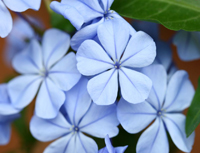 | Baby Cheeks
Seasons: Spring
Appearance: These small, pale blue flowers grow in bunches close to the ground, with wide leaves with jagged edges. They have a pale, sweet scent.
Purposes: Baby cheeks are so named for being common gifts to a new mother. On holidays celebrating children and motherhood, a bouquet lined with baby cheeks is common.
Clime: These plants rarely grow wild, except in rare, lucky cases. They need to grow with plenty of water, in a cultivated, sunny garden.
|
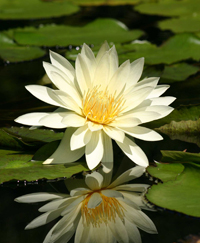 | Bluevein Pond Lily
Seasons: Spring-Early Fall
Appearance: Lily pads are commonly found in stagnant ponds off-shooting from the river, unless care is take to remove them. Lilies can grow to be as large as their pads, 6 inches or more across. White pointed petals surround a yellow center, though pink mutations can occasionally be seen.
Purposes: Lilies have a unique scent, floral and citrus-y, though most are not willing to venture out into the ponds to harvest them.
Clime: Lilies bloom early and late in the year, and are quite hardy flowers. Warm sun and water make them grow to their largest sizes. If the water is too rough, however, lilies and their pads will not take root.
|
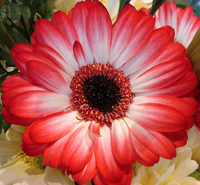 | Fortila
Seasons: Mid-Late Summer
Appearance: Large, lush, red and white blossoms that grow singularly on stalks. The blossoms grow to 3-6 inches across, and the stalks themselves can grow as high as 5 feet, though most top off at 3 or 4. Fortilas growing near the waterfall get more water than most others, and will grow higher.
Purposes: The scent is exceptional, with a strong musky scent that is popular among the more sensual varieties of perfume. Children with an affinity for gardening will grow playhouses out of the tall stalks. For events between lovers, the petals are a favorite to incorporate, for the scent and passionate red colors.
Clime: Fortilas need a warm climate and thick soil to grow. Stunted varieties may sprout down on the beach, but their scents are weak and the plants themselves are shortlived.
|
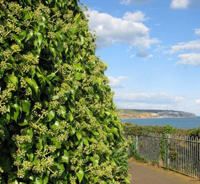 | Cliff Ivy
Seasons: Year Round
Appearance: Cliff ivy is made up of small, pointed leaves that proliferates, web-like, over any textured surface. In the spring, small, petal-less stamens pop out in sets of five throughout the vines. In the summer, these blossom into tiny white flowers for only a few short weeks, before the petals, and eventually the stamens, fall off, leaving only the ivy. In the winter, the newest leaves and lone tendrils will die off, but leave the main masses alive.
Purposes: Usually regarded as a nuisance, cliff ivy must be cut back and otherwise kept in check if one does not want it overtaking the entire side of their house, or the cliff face. During the few weeks the ivy is in bloom, the ivy is regarded as a thing of beauty, and plans to cut it are often delayed until the flowers die.
Clime: While not found at the edge of the sea, the ivy clings to anywhere else, including structures, cliff faces, and trees. While cold does not kill it, the driest of times will make it wither, though it always comes right back with a good rain.
|
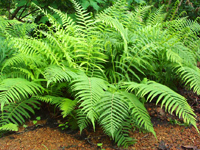 | Common Cyphrus Ferns
Seasons: Spring - Fall
Appearance: An unremarkable bush of light green ferns. They can grow to several feet high, with spreads of over five feet if left unchecked. Commonly grows collections, rather than a single bush.
Purposes: Found in many of Riverfall’s gardens, and occasionally kept as a yard or houseplant. If mashed into a paste, makes a strong green dye.
Clime: Found throughout Cyphrus, though bushes grow scraggly with lack of water.
|
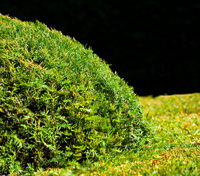 | Fallshrub
Seasons: Year Round
Appearance: Grows in a large, dense bush full of sap-sticky branches and tiny, needlelike leaves. Typically does most of its growing during the fall season, hence the name, and grows very little throughout the rest of the year.
Purposes: Fallshrubs are very popular for hedgerows between houses, and for expensive landscaping at the more wealthy homes. They can be grown and cut into a variety of shapes, and the skilled gardener takes advantage of the months will little growth to maintain a single shape that can be altered again the next fall.
Clime: While not found very close to the ocean, fallshrubs are present on every tier of the cliff. and wild, smaller shrubs can be found outside the city.
|
 | Leaning Celphis
Seasons: Year Round
Appearance: A short, stubby tree that grows quickly and is usually seen en masse, having taken over outcroppings in the cliffs. Leaves are long, hard, and thin, with a sour scent if broken. The roots are shallow, and the trees typically lean from lack of support in the shallow soil on the cliffs. These trees grow exclusively near the ocean, where they’ve developed the ability to process the saline from the ocean and live off of the sea water. Very old trees, if they’ve lasted long enough without falling off the cliff, develop salt crystals in their bark where sap would normally gather. After 40 years, a Leaning Celphis is so laden with salt crystals that the leaves have long since fallen off and the branches can be easily shattered.
Purposes: The Leaning Celphis is regarded as a nuisance, though it typically inhabits areas that are unpopulated. The salt produced in the trees is unusable in food, as it leaves a mineral, chalky taste.
Clime: Found on the outskirts of Riverfall, along the cliffs. Seen progressively on the higher cliff levels, where it is too far away to receive salt sprays from the ocean.
|
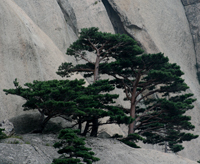 | Crag Firs
Seasons: Year Round
Appearance: Crag firs are evergreen, staying green all year round. In place of leaves, the branches have needles that sprout in bunches. The trees grow small, often no higher than six feet, and have thin, tendril-like roots that can burrow deep into the cracks of the cliff face. They usually have a wind-swept look about them, bent with the wind that howls around the uninhabited areas of the cliffs.
Purposes: Occasionally found transplanted in Riverfall’s gardens, where they readily adapt to soil, crag firs generally go unregarded. Sprigs of the branches may be brought into the home for winter-themed decoration, or for a fresh scent.
Clime: Found throughout Riverfall and extending into the Sea of Grass.
|